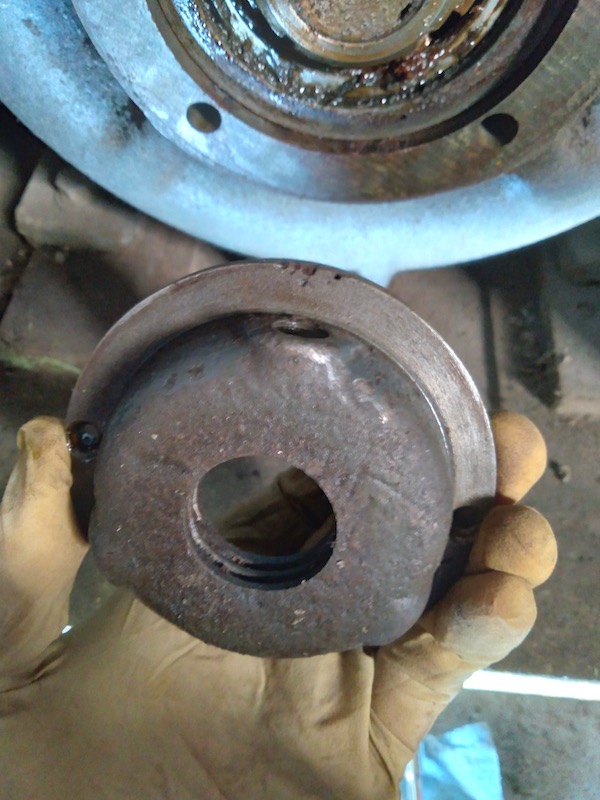| Author |
 Topic Search Topic Search  Topic Options Topic Options
|
wjohn 
Orange Level


Joined: 19 Jan 2010
Location: KS
Points: 2265
|
 Post Options Post Options
 Thanks(0) Thanks(0)
 Quote Quote  Reply Reply
 Topic: Allis-Chalmers Powered Grinder Topic: Allis-Chalmers Powered Grinder
Posted: 28 Dec 2022 at 10:35pm |
I've been coming across more and more jobs that need something along the lines of a surface grinder, so I was interested when this one came up for sale nearby. Then I saw it had an AC motor and figured that was a sign. It's a Gallmeyer & Livingston No. 4 Universal Grinder with the surface grinder attachment and a Brown and Sharpe magnetic chuck. I found a price list from the '40s that mentions this model, so it may be around that time frame. The same price list shows it being 1850 lbs. Anyone every used anything from Gallmeyer & Livingston before?
It's missing the diamond dresser so I need to figure something out for that, and I'm not sure that the power feed works... But otherwise, everything spins like it should and feels nice and tight. The motor sounds great. I have a pile of grinding wheels that came with it.
I need to do some more wiring in my shop to add another 240V outlet, and figure out if a VFD, phase converter, etc. is the best way to go since I don't have 3 phase. Anyone have any thoughts on this for farm/home use? I'd like to add a mill someday and maybe a lathe too... and being flexible on 3 vs single phase is helpful.
I have used a surface grinder zero times in my life so there will be a lot of learning needed too.
|
|
1939 B, 1940 B, 1941 WC, 1951 WD, 1952 CA, 1956 WD-45
|
 |
|
Sponsored Links
|
|
 |
IBWD MIke 
Orange Level


Joined: 08 Apr 2012
Location: Newton Ia.
Points: 4154
|
 Post Options Post Options
 Thanks(0) Thanks(0)
 Quote Quote  Reply Reply
 Posted: 29 Dec 2022 at 8:28am Posted: 29 Dec 2022 at 8:28am |
John, I've ran quite a few surface grinders, never heard of that brand. My first big concern would be the lack of a guard on the wheel. Wouldn't think a diamond dresser would be that hard to come up with, E-bay maybe?
Have thought about buying something similar different times myself. Lack of somewhere to put it has always killed that deal. I need a mill a lot more often, just don't do that much 'fine' work on the farm.
|
 |
steve(ill) 
Orange Level Access

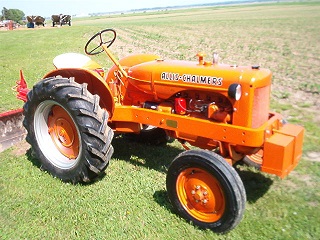
Joined: 11 Sep 2009
Location: illinois
Points: 88680
|
 Post Options Post Options
 Thanks(0) Thanks(0)
 Quote Quote  Reply Reply
 Posted: 29 Dec 2022 at 8:54am Posted: 29 Dec 2022 at 8:54am |
VFD would be great for that application.. You need a small HP, 3 phase motor, 240v , that might need a speed control added............. THats what the VFD does... They work great on the 1-5 HP 3 phase motors..
You could setup a "3 phase wiring" across one wall of the shop... The "VFD" would have a 240v single phase feed, andd then 3 phases out... to 2-3 different plugs for different machines.... Run one at a time ......... If you want variable speed, it might be nice to have the VFD close to the machine... BUT if you just need to convert to 3 phase , you could power various machines. .... some of that depends if the machine has a ON- OFF switch, or is it Hard Wired..
Edited by steve(ill) - 29 Dec 2022 at 8:56am
|
|
Like them all, but love the "B"s.
|
 |
bigal121892 
Orange Level

Joined: 05 Jan 2010
Location: Nebraska
Points: 815
|
 Post Options Post Options
 Thanks(0) Thanks(0)
 Quote Quote  Reply Reply
 Posted: 29 Dec 2022 at 3:24pm Posted: 29 Dec 2022 at 3:24pm |
|
I don't think that motor will work with a VFD, it's too old. Would be best to have a 3ø motor that is inverter duty rated. As far as speed control goes, most VFD's have a 10VDC power supply built in, use that with a pot to the analo input; use the pot to adjust the speed.
|
 |
steve(ill) 
Orange Level Access


Joined: 11 Sep 2009
Location: illinois
Points: 88680
|
 Post Options Post Options
 Thanks(0) Thanks(0)
 Quote Quote  Reply Reply
 Posted: 29 Dec 2022 at 4:20pm Posted: 29 Dec 2022 at 4:20pm |
|
Allen, what kind of problems have you seen with a VFD on an "old" motor ?
|
|
Like them all, but love the "B"s.
|
 |
bigal121892 
Orange Level

Joined: 05 Jan 2010
Location: Nebraska
Points: 815
|
 Post Options Post Options
 Thanks(0) Thanks(0)
 Quote Quote  Reply Reply
 Posted: 29 Dec 2022 at 7:09pm Posted: 29 Dec 2022 at 7:09pm |
|
With line 3ø, the voltage is in the form of a sine wave, rises from zero volts, to ~670 volts, then back to zero volts, giving an RMS value of 480VAC. With a VFD voltage going to the windings is a pulse width modulated wave, i.e. it spikes to full power then off, spikes to full power, then off, only the current appears as a sine wave. As the VFD pulses the voltage on and off, (it's the width of the pulses that determine the voltage the motor windings "see"). Therefore the peak voltage is there a lot longer, and he old windings, were never insulated for this kind of operation, and the voltage leaks from the old windings, and breaks down the enamel. If you look at the nameplate of motors on VFD's, they will say Inverter Duty, on them, the enamel on the windings is thicker, to withstand the pulsed voltage.
Edited by bigal121892 - 29 Dec 2022 at 7:11pm
|
 |
steve(ill) 
Orange Level Access


Joined: 11 Sep 2009
Location: illinois
Points: 88680
|
 Post Options Post Options
 Thanks(0) Thanks(0)
 Quote Quote  Reply Reply
 Posted: 29 Dec 2022 at 7:22pm Posted: 29 Dec 2022 at 7:22pm |
|
I think the overheating and break down of insulation is true if you try to run an OLD motor rated at 1800 rpm down to 500 RPM... the insulation and fan cooling the motor were not designed to do that........ If you just use the VFD as a Phase Converter and want the 3 phase output, but retain the original 1800 rpm... i think you should be fine.
|
|
Like them all, but love the "B"s.
|
 |
wjohn 
Orange Level


Joined: 19 Jan 2010
Location: KS
Points: 2265
|
 Post Options Post Options
 Thanks(0) Thanks(0)
 Quote Quote  Reply Reply
 Posted: 29 Dec 2022 at 7:33pm Posted: 29 Dec 2022 at 7:33pm |
 IBWD MIke wrote: IBWD MIke wrote:
John, I've ran quite a few surface grinders, never heard of that brand. My first big concern would be the lack of a guard on the wheel. Wouldn't think a diamond dresser would be that hard to come up with, E-bay maybe?
Have thought about buying something similar different times myself. Lack of somewhere to put it has always killed that deal. I need a mill a lot more often, just don't do that much 'fine' work on the farm.
|
Mike, not shown are a couple of guards in the bottom of one of the boxes of grinding wheels. I started looking at diamond dressers today and yeah, it looks like I'll be able to come up with a new one that will mount up okay, even if I can't find an original. Just have to figure out which one has the best mounting at a decent price. I haven't found a pic of an original dresser yet which would be nice to see.
|
|
1939 B, 1940 B, 1941 WC, 1951 WD, 1952 CA, 1956 WD-45
|
 |
wjohn 
Orange Level


Joined: 19 Jan 2010
Location: KS
Points: 2265
|
 Post Options Post Options
 Thanks(0) Thanks(0)
 Quote Quote  Reply Reply
 Posted: 29 Dec 2022 at 9:05pm Posted: 29 Dec 2022 at 9:05pm |
|
Steve and Al, thanks for the discussion. It is definitely an old motor - I did a little bit of searching for an Allis-Chalmers AR type motor and haven't come up with anything. I'll need to do more research to see if a VFD is even okay for this application. Maybe I won't have much of a choice when it comes down to it.
|
|
1939 B, 1940 B, 1941 WC, 1951 WD, 1952 CA, 1956 WD-45
|
 |
DaveKamp 
Orange Level Access

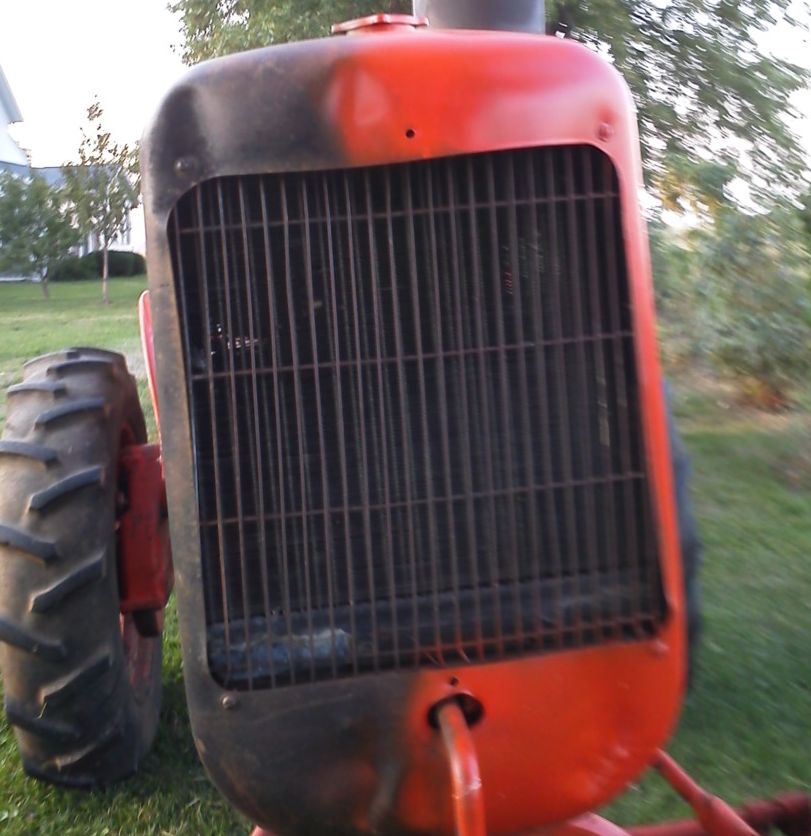
Joined: 12 Apr 2010
Location: LeClaire, Ia
Points: 6091
|
 Post Options Post Options
 Thanks(1) Thanks(1)
 Quote Quote  Reply Reply
 Posted: 29 Dec 2022 at 11:08pm Posted: 29 Dec 2022 at 11:08pm |
|
There is absolutely NO reason to be concerned with the 'old' Allis motor's serviceability with a VFD...
first of all, Allis's electric motors of the 1950s were better in winding security and insulation quality than most "inverter duty" motors offered new today.
Second, the Allis's frame and lamination quality, air gap, fitment and airflow far outclass everything else.
My Monarch 10EE has a 7.5hp 1800rpm 480v Allis Chalmers driven by an Allen Bradley 1336F drive, programmed for 3hz to 215hz, which yields armature speed of 0 to 6400RPM... Drives the 10EE'S spindle through a 3.5:1 toothed belt reduction, and lays down enough torque at ANY speed capable of ripping a man's arms right off.
The suggestion that it'll be at risk is totally invalid. all one should do, is remove the motor driven cooling fan, install a shroud with a constant speed blower, because the motor can still not move cooling air well at partial speed, and it'll become a howling air raid siren once you run up past 60hz.
it would be a worthy exercise to pop the end bells off, clean out the interior, and slip in a new set of bearings, and make certain the shaft grounding clips are in place.
Most of my machine tools are 3phase, are driven by used VFDs, and frequently by 480vac single phase derived from dry transformers wired in reverse. NONE have 'inverter duty' ratings, and none have ever failed, in both operational performance,AND a high-pot test to 1.5kv
|
|
Ten Amendments, Ten Commandments, and one Golden Rule solve most every problem. Citrus hand-cleaner with Pumice does the rest.
|
 |
IBWD MIke 
Orange Level


Joined: 08 Apr 2012
Location: Newton Ia.
Points: 4154
|
 Post Options Post Options
 Thanks(0) Thanks(0)
 Quote Quote  Reply Reply
 Posted: 30 Dec 2022 at 7:33am Posted: 30 Dec 2022 at 7:33am |
|
John, the diamond dresser I used the most was pretty simple. Just mounted in a small crs block. Stick it on the magnetic chuck and dress the wheel. Have seen a few surface grinders that had a dresser on the machine but only used one once or twice.
|
 |
Coke-in-MN 
Orange Level Access

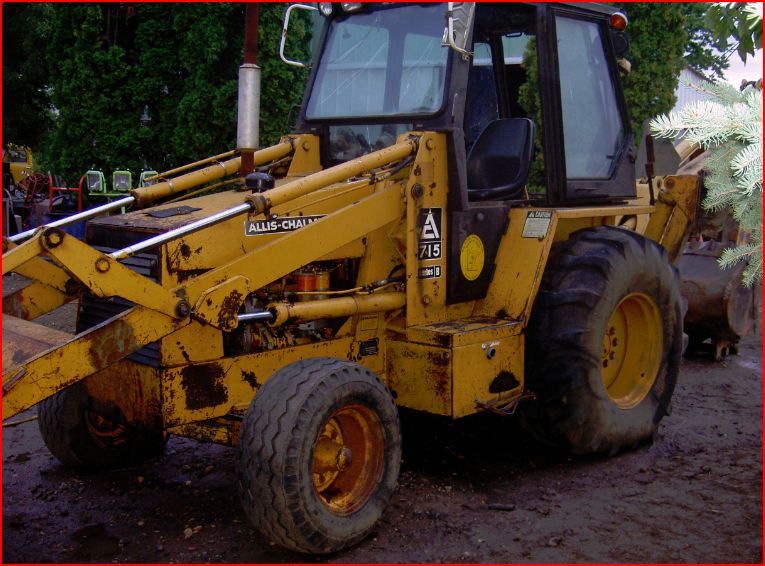
Joined: 12 Sep 2009
Location: Afton MN
Points: 42055
|
 Post Options Post Options
 Thanks(0) Thanks(0)
 Quote Quote  Reply Reply
 Posted: 30 Dec 2022 at 12:01pm Posted: 30 Dec 2022 at 12:01pm |
|
Looking at the Amp draw on the motor - it seems low enough that a single phase motor would be a replacement at a low cost . Son just bought couple 3 HP motors and a 5 HP on auction site around here for under $50 each
other thing would be using a 3 ph motor as the source of the 3 phase while running it on single ph 220 v
|
|
Life lesson: If you’re being chased by a lion, you’re on a horse, to the left of you is a giraffe and on the right is a unicorn, what do you do? You stop drinking and get off the carousel.
|
 |
DaveKamp 
Orange Level Access


Joined: 12 Apr 2010
Location: LeClaire, Ia
Points: 6091
|
 Post Options Post Options
 Thanks(0) Thanks(0)
 Quote Quote  Reply Reply
 Posted: 30 Dec 2022 at 8:53pm Posted: 30 Dec 2022 at 8:53pm |
|
A rotary would work fine for this.
the grinding wheel on this machine will never cut harder than 3/4hp...
the reason why they used a substantially larger motor, was to provide stable wheel speed and constant left to right motion while cutting.
One of my surface grinders only runs a 1/2hp spindle motor... the table is manual motion. if the operator puts too much load on the wheel, the grind quality goes to pot, as the whhel speed,abrasive loss, etc becomes inconsistent, abs the workpiece overheats
|
|
Ten Amendments, Ten Commandments, and one Golden Rule solve most every problem. Citrus hand-cleaner with Pumice does the rest.
|
 |
Les Kerf 
Orange Level

Joined: 08 May 2020
Location: Idaho
Points: 1423
|
 Post Options Post Options
 Thanks(0) Thanks(0)
 Quote Quote  Reply Reply
 Posted: 31 Dec 2022 at 5:24am Posted: 31 Dec 2022 at 5:24am |
 bigal121892 wrote: bigal121892 wrote:
With line 3ø, the voltage is in the form of a sine wave, rises from zero volts, to ~670 volts, then back to zero volts, giving an RMS value of 480VAC. With a VFD voltage going to the windings is a pulse width modulated wave, i.e. it spikes to full power then off, spikes to full power, then off, only the current appears as a sine wave. As the VFD pulses the voltage on and off, (it's the width of the pulses that determine the voltage the motor windings "see"). Therefore the peak voltage is there a lot longer, and he old windings, were never insulated for this kind of operation, and the voltage leaks from the old windings, and breaks down the enamel. If you look at the nameplate of motors on VFD's, they will say Inverter Duty, on them, the enamel on the windings is thicker, to withstand the pulsed voltage.
|
RMS (Root-Mean-Squared) is the DC heating equivalent value of AC; if this value is deliberately exceeded by leaving the peak voltage "there a lot longer" then the VFD is set up incorrectly and damage may well occur.
|
 |
DaveKamp 
Orange Level Access


Joined: 12 Apr 2010
Location: LeClaire, Ia
Points: 6091
|
 Post Options Post Options
 Thanks(1) Thanks(1)
 Quote Quote  Reply Reply
 Posted: 31 Dec 2022 at 8:05am Posted: 31 Dec 2022 at 8:05am |
|
the Allis motor will certainly withstand a hipot test well over 1000v... the insulation quality of these motors is fantastic.
It is not the peak value that is of any concern, it is the HF component of switching noise that generates the highest intertwinding voltages, and the greatest harmonic physical stress on windings and as already noted, and these motors are beasts... and running this one in a home environment would most likely be on 240v single phase, that means windings are in series, so reactance is much higher, which quells the HF component nicely.
There are countries where three phase power is common in homes, and as a result, they're lots of consumer-grade 3ph motors around. this is NOT the case in the US... homes that DO, are usually corner grounded delta, usually in very old residential, sometimes agricultural areas, and the end result of this, is that three phase motors heee, are basically always industrial quality.
most people that kill a three phase motor with a VFD, is to run it at low speed, with no additional cooling. in the case of this grinder, that won't happen, it's a fixed speed application.
The LEAST complicated solution is to swap in a capacitor start 240v single phase, like a farm duty 5hp.
|
|
Ten Amendments, Ten Commandments, and one Golden Rule solve most every problem. Citrus hand-cleaner with Pumice does the rest.
|
 |
wjohn 
Orange Level


Joined: 19 Jan 2010
Location: KS
Points: 2265
|
 Post Options Post Options
 Thanks(0) Thanks(0)
 Quote Quote  Reply Reply
 Posted: 02 Jan 2023 at 10:11am Posted: 02 Jan 2023 at 10:11am |
Lots to think about - thanks everyone.
If I were to install a VFD, I don't think I would be using it to run the motor below it's intended speed. As Dave said, there's not a lot of advantage to that with a surface grinder and certainly not worth the risk of having inadequate cooling. About the only speed control aspect of it I would use might be to soft start it - besides using it for 3ph. I will have single phase 240V as the source so I'll have to convert somehow.
I hadn't thought about changing out the motor. I guess if I come across a cheap single phase 224 frame one, I could swap it out and run off single phase. I'm not going to lie though... I like the cool factor of the AC motor.
Speaking of, I did find some general literature from AC that mentions the AR type motor:
I also found a government OPS price list from 1953 that showed ending serial numbers for a few different years. Based on that, my machine was built sometime no later than 1947, and probably not much before then. There's a good chance this originally came from an aircraft production facility.
|
|
1939 B, 1940 B, 1941 WC, 1951 WD, 1952 CA, 1956 WD-45
|
 |
bigal121892 
Orange Level

Joined: 05 Jan 2010
Location: Nebraska
Points: 815
|
 Post Options Post Options
 Thanks(0) Thanks(0)
 Quote Quote  Reply Reply
 Posted: 02 Jan 2023 at 11:35am Posted: 02 Jan 2023 at 11:35am |
The VFD will do the phase conversion for you, just need to upsize the VFD by 1 motor size. From the picture, it looks like the motor is a 1.5 HP, then you need a VFD for a 2.0 or 3.0Hp motor, rated for 200 to 240 volts. The larger size VFD is needed for the extra capacitance, to maintain the DC buss voltage.
Edited due to not paying attention.
Edited by bigal121892 - 02 Jan 2023 at 3:01pm
|
 |
steve(ill) 
Orange Level Access


Joined: 11 Sep 2009
Location: illinois
Points: 88680
|
 Post Options Post Options
 Thanks(0) Thanks(0)
 Quote Quote  Reply Reply
 Posted: 02 Jan 2023 at 12:42pm Posted: 02 Jan 2023 at 12:42pm |
cant see the motor HP very well ......... but the 240v and 4.2 amps is visible.... 240 x 4.2 is about 1000 watts... that might be 1.5 HP instead of 15..
Agree, use a VFD a little bigger... 2-3 HP should work.
I made a "STATIC PHASE CONVERTER" for my 3 HP lathe about 20 years ago, before the VFD were popular..... Several big Capacitors wired into the circuit to make a START and RUN circuit gives a half way decent " third phase".
Edited by steve(ill) - 02 Jan 2023 at 12:47pm
|
|
Like them all, but love the "B"s.
|
 |
wjohn 
Orange Level


Joined: 19 Jan 2010
Location: KS
Points: 2265
|
 Post Options Post Options
 Thanks(0) Thanks(0)
 Quote Quote  Reply Reply
 Posted: 02 Jan 2023 at 2:32pm Posted: 02 Jan 2023 at 2:32pm |
I can't read the exact HP on the tag either, even in person. I can tell it's some fraction starting with 1, so I think it's 1 1/4, 1 1/3, or 1 1/2 HP. VFDs in the 2-3 HP range are pretty reasonable. I think that will be the cheapest option unless I luck into a used single phase motor that would drop right in.
The pipe plug on the end of the motor... I assume that's a lube point for the bearings? Does anyone know if these used a grease or an oil?
|
|
1939 B, 1940 B, 1941 WC, 1951 WD, 1952 CA, 1956 WD-45
|
 |
bigal121892 
Orange Level

Joined: 05 Jan 2010
Location: Nebraska
Points: 815
|
 Post Options Post Options
 Thanks(0) Thanks(0)
 Quote Quote  Reply Reply
 Posted: 02 Jan 2023 at 2:58pm Posted: 02 Jan 2023 at 2:58pm |
|
Boy or boy, this cold must have knocked me worst then I thought, 15Hp motor at 4.2 amps is efficient. :) If you blow the picture up just right, it does appear to be a 1.5Hp motor, therefore it would require a 2 or 3Hp VFD.
|
 |
DaveKamp 
Orange Level Access


Joined: 12 Apr 2010
Location: LeClaire, Ia
Points: 6091
|
 Post Options Post Options
 Thanks(0) Thanks(0)
 Quote Quote  Reply Reply
 Posted: 02 Jan 2023 at 3:26pm Posted: 02 Jan 2023 at 3:26pm |
 wjohn wrote: wjohn wrote:
The pipe plug on the end of the motor... I assume that's a lube point for the bearings? Does anyone know if these used a grease or an oil?
|
On mine, John, the bearings were sealed double-shielded, and that was a thread-on dust cover, underneath was an oiled felt disk, through which a contact pin on a spring grounded the center of the armature to the end bell. Yours looks a little different, but My gut says they may have done something similar here.
If you think about it, this was very much 'ahead of it's time' in comparison to OTHER motor manufacturers... two things happen with motors... belt friction generates static charges, which discharge through the bearings and races (eroding them) and (particularly with VFDs, but any OTHER noise) HF oscillations occur inside the armature that want to conduct through the end bells into the frame, again, having a pathway that bypasses the bearings is a great thing. Darned few motors have that feature today, and frankly, too many motors have lousy shaft balance, way too much gap, and poor varnish penetration... lossy and weak. Keep in mind, Allis was building 750,000v transmission transformers by the thousands, 29kv distribution transformers by the millions, and 7900v customer drop transformers by the tens of millions, so 480v motors and 240v motors' insulation quality was really second-nature.
The Allis electric motor that I used in my Monarch 10EE VFD conversion originally came from a 400-gallon Quincy air compressor that'd taken a spill and bent the compressor crank. The motor sheave was cracked, but the motor shaft was unscathed. I disassembled the motor, pressure washed the parts, shoveled several pounds of crud out of the inside, pressure washed it again, painted and gave it a new set of bearings, yanked the shaft fan, fitted a shroud and fixed-speed cooling fan, but I reassembled with all those grounding features intact, fitted the toothed belt sheave, and installed it in the 10EE's belly. It's a BRUTE... ;-)
I really think the best solution for you here, is go for a single-phase motor... or make a simple rotary converter. If you do the former, keep the Allis motor on the shelf for future use, eventually you WILL find need, but for this grinder, a constant-speed/simple solution is better.
Edited by DaveKamp - 02 Jan 2023 at 3:28pm
|
|
Ten Amendments, Ten Commandments, and one Golden Rule solve most every problem. Citrus hand-cleaner with Pumice does the rest.
|
 |
steve(ill) 
Orange Level Access


Joined: 11 Sep 2009
Location: illinois
Points: 88680
|
 Post Options Post Options
 Thanks(0) Thanks(0)
 Quote Quote  Reply Reply
 Posted: 02 Jan 2023 at 4:09pm Posted: 02 Jan 2023 at 4:09pm |
|
I vote for the VFD.... keep that OLD ALLIS GOING !!
|
|
Like them all, but love the "B"s.
|
 |
wjohn 
Orange Level


Joined: 19 Jan 2010
Location: KS
Points: 2265
|
 Post Options Post Options
 Thanks(0) Thanks(0)
 Quote Quote  Reply Reply
 Posted: 03 Jan 2023 at 7:09pm Posted: 03 Jan 2023 at 7:09pm |
 DaveKamp wrote: DaveKamp wrote:
On mine, John, the bearings were sealed double-shielded, and that was a thread-on dust cover, underneath was an oiled felt disk, through which a contact pin on a spring grounded the center of the armature to the end bell. Yours looks a little different, but My gut says they may have done something similar here. |
Thanks Dave. I guess I can try to pull the easy end cap of the motor off and have a look. I am thinking these have to be grease plugs. If oil were intended I would think they'd be the little oil caps. It would be interesting if these actually turned out to be sealed.
Hate to abandon this motor for some of the reasons you said... This should be a pretty high quality, well-balanced motor, which from what I am reading is pretty important for a surface grinder. I think a comparable quality single-phase motor is going to be pretty pricey, so the VFD may not be so bad.
|
|
1939 B, 1940 B, 1941 WC, 1951 WD, 1952 CA, 1956 WD-45
|
 |
wjohn 
Orange Level


Joined: 19 Jan 2010
Location: KS
Points: 2265
|
 Post Options Post Options
 Thanks(0) Thanks(0)
 Quote Quote  Reply Reply
 Posted: 03 Jan 2023 at 7:28pm Posted: 03 Jan 2023 at 7:28pm |
 steve(ill) wrote: steve(ill) wrote:
I vote for the VFD.... keep that OLD ALLIS GOING !! |
Thanks Steve! I'd love to. I have a little time to figure things out since I have to run the electrical in that part of the shop first.
I did spend a little time yesterday messing around with the power feed mechanism. This unit has mechanical power drive for the side-side table motion, which would be nice if I can get it to work. I've isolated it to the engagement clutch/coupling between two shafts so I need to do some more teardown to see any more. Everything on the backside of that coupling in the power feed gearbox turns, and everything on the table side turns with the hand wheel. It's just all hidden inside a casting.
I didn't expect to have any kind of power feed in the price range of machines I was looking at so if I can't easily fix it, no big deal... but it sure would save a lot of hand wheel turning.
|
|
1939 B, 1940 B, 1941 WC, 1951 WD, 1952 CA, 1956 WD-45
|
 |
DaveKamp 
Orange Level Access


Joined: 12 Apr 2010
Location: LeClaire, Ia
Points: 6091
|
 Post Options Post Options
 Thanks(0) Thanks(0)
 Quote Quote  Reply Reply
 Posted: 03 Jan 2023 at 9:41pm Posted: 03 Jan 2023 at 9:41pm |
The fact of a surface grinder, is that the plane of travel needs to be parallel to the wheel's axis, and it's fore-aft travel needs to stay true. Side-to-side will inherently stay true. Once that's set, the wheel's contact pressure, and the consistency of it's travel across the workpiece, determines it's accuracy and finish quality.
IF the grinder is totally hand-operated, that entire second group of factors is no longer controlled... so it will NOT be easy to stay consistent in performance.
Suffice to say that the side-to-side feed is actually more responsible for accuracy, than most any other factor.
I helped a buddy BUILD a high-precision surface grinder three-and-a-half decades ago. We built it in his basement, and it was capable of absolutely insane precision. We cut an old broken granite countertop into three pieces of granite... one as the bed, the other as the table. We worked them flat using the 'whitworth three plates' method, and we used cranberry juice instead of blue dye (because that's what we had). We drilled holes in the table, threaded them, and connected air lines fed by a pressure regulator, just enough flow to 'float' the table. We used simple wood block guides to keep it straight, and we used pneumatic cylinders with adjustable control orfices and a 'lost motion' linkage on the shuttle valve to push the table left-to-right. We mounted an ordinary bench grinder motor beneath, with a belt to the spindle, and attached a mechanical magnetic chuck to the top of the bed, upon which he'd attach fixtures to hold a variety of interesting glass objects used for precision optical things... usually special rod-type lenses or mirrors... curved on one side, and flat on the other.
He could grind and polish the backs of his lenses and mirrors to incredible silly precision (IIRC, it was something like tenths of microns), with something made from basically junk.
It is amazing what a person can do, when they keep the actual physics of something in a higher point of attention than irrelevant predispositions.
Edited by DaveKamp - 03 Jan 2023 at 9:41pm
|
|
Ten Amendments, Ten Commandments, and one Golden Rule solve most every problem. Citrus hand-cleaner with Pumice does the rest.
|
 |
Tracy Martin TN 
Orange Level Access


Joined: 11 Sep 2009
Location: Gallatin,TN
Points: 10853
|
 Post Options Post Options
 Thanks(0) Thanks(0)
 Quote Quote  Reply Reply
 Posted: 04 Jan 2023 at 5:33pm Posted: 04 Jan 2023 at 5:33pm |
|
They made good stuff. That is more of a cutter grinder than surface grinder. It will work for most cases. There are you tube videos that may help you out. Tracy
|
|
No greater gift than healthy grandkids!
|
 |
wjohn 
Orange Level


Joined: 19 Jan 2010
Location: KS
Points: 2265
|
 Post Options Post Options
 Thanks(0) Thanks(0)
 Quote Quote  Reply Reply
 Posted: 12 Feb 2023 at 10:46pm Posted: 12 Feb 2023 at 10:46pm |
I popped the end cap off the non-drive side of the motor and decided I should at least regrease the bearings (Dave - this bearing at least seemed to be tight and in good shape). No corrosion, but the old grease is pretty dry. I'll try to pull off the drive pulleys on the other end so I can inspect/regrease that bearing, too.
The pipe plug in the end cap goes into that cavity - however, the center of the end cap is open to the world. I'm thinking some sort of expansion plug or something fell out of there, because it should be holding the grease in place. When bolted in place you can see/touch the end of the motor shaft. Glad I caught it now when I have the grinder away from the wall and this stuff is easier to access.
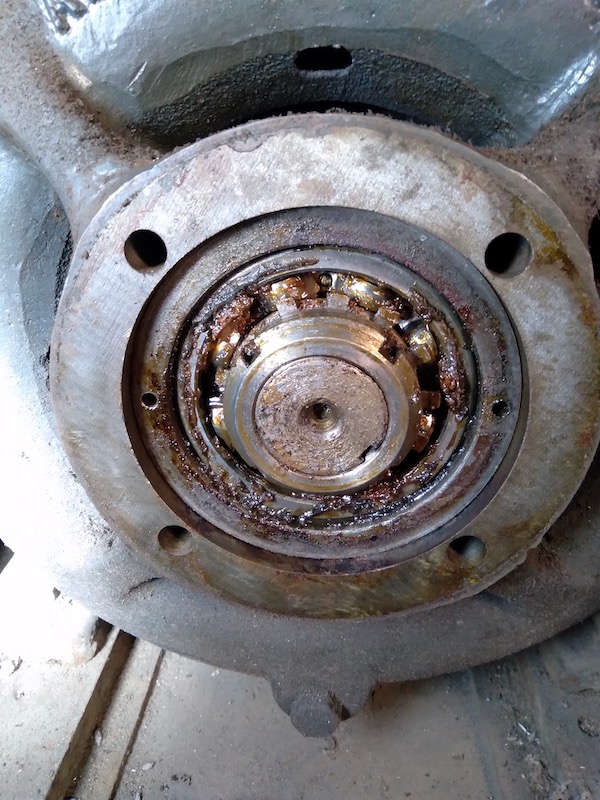
|
|
1939 B, 1940 B, 1941 WC, 1951 WD, 1952 CA, 1956 WD-45
|
 |
DaveKamp 
Orange Level Access


Joined: 12 Apr 2010
Location: LeClaire, Ia
Points: 6091
|
 Post Options Post Options
 Thanks(2) Thanks(2)
 Quote Quote  Reply Reply
 Posted: 13 Feb 2023 at 7:13am Posted: 13 Feb 2023 at 7:13am |
THAT is a different pipe-plug arrangement than what I was envisioning.
That bearing looks like an adjustable, but I don't think it is... but it may have provision for some sort of preload or preload limitation.
IF it is the SPINDLE motor (not in the base of the machine) then that's a high-precision/close tolerance bearing system. If it's just a motor with a belt sheave, then it wouldn't be a big deal.
There is one comment about single vs. 3 phase on grinding centers... surface noise. On direct-motorized spindles, the magnetic action of the armature causes some harmonic motion to appear in the spindle as the motor runs, and that harmonic motion can cause the grinding wheel to deflect slightly, and gyrate while it spins. Guys who do extreme precision work will note the wheel's gyration will leave a 'pattern' on a part as it cuts.
I don't cut anything to that precision, but I have seen that sort of pattern on parts placed my optical comparator screen. If you were making high-speed spindles, or scientific equipment, it might be a problem, but if not, doubt you'd care.
|
|
Ten Amendments, Ten Commandments, and one Golden Rule solve most every problem. Citrus hand-cleaner with Pumice does the rest.
|
 |
CTuckerNWIL 
Orange Level

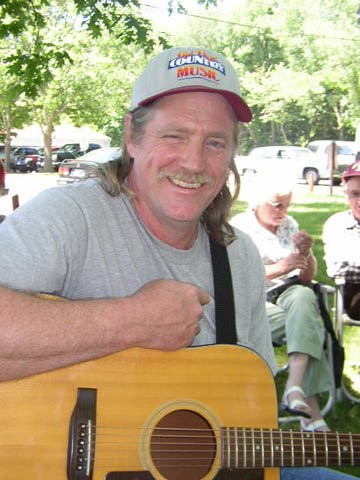
Joined: 11 Sep 2009
Location: NW Illinois
Points: 22825
|
 Post Options Post Options
 Thanks(0) Thanks(0)
 Quote Quote  Reply Reply
 Posted: 13 Feb 2023 at 7:30am Posted: 13 Feb 2023 at 7:30am |
 IBWD MIke wrote: IBWD MIke wrote:
John, the diamond dresser I used the most was pretty simple. Just mounted in a small crs block. Stick it on the magnetic chuck and dress the wheel. Have seen a few surface grinders that had a dresser on the machine but only used one once or twice.
|
My thoughts exactly. I did a LOT of grinding over the years, mostly by using a block of steel with a diamond on it, to dress the wheel from the magnetic chuck.
|
|
|
 |
wjohn 
Orange Level


Joined: 19 Jan 2010
Location: KS
Points: 2265
|
 Post Options Post Options
 Thanks(0) Thanks(0)
 Quote Quote  Reply Reply
 Posted: 13 Feb 2023 at 9:24pm Posted: 13 Feb 2023 at 9:24pm |
 DaveKamp wrote: DaveKamp wrote:
THAT is a different pipe-plug arrangement than what I was envisioning.
That bearing looks like an adjustable, but I don't think it is... but it may have provision for some sort of preload or preload limitation.
IF it is the SPINDLE motor (not in the base of the machine) then that's a high-precision/close tolerance bearing system. If it's just a motor with a belt sheave, then it wouldn't be a big deal. |
I'm still not sure I fully understand the end cap. There is also a slotted flathead machine screw 120 degrees apart from the pipe plug, in one of those slight bosses in the cap by my fingers. The third boss is undrilled. Regardless of intent of everything going on there, if I seal that open end hole back up, it should hold grease properly... Although now I'm wondering if there was something in that end hole that allowed grease to pass to the outside, away from the motor, when enough pressure was reached while it was being greased? If so I'll just have to be careful not to overgrease if I put in a hard welch plug or similar.
No context in my photos for sure... all close ups. This motor is mounted to the bottom inside of the base casting, with a 3 v belt drive from the motor to another shaft, which then drives a flat belt that snakes all the way to the spindle up top. So, these motor bearings shouldn't be extra critical since it's not a spindle motor.
There does appear to be some sort of adjustment nut with a staking washer on the end of the shaft for bearing adjustment.
|
|
1939 B, 1940 B, 1941 WC, 1951 WD, 1952 CA, 1956 WD-45
|
 |









 Topic Options
Topic Options


 Post Options
Post Options Thanks(0)
Thanks(0)

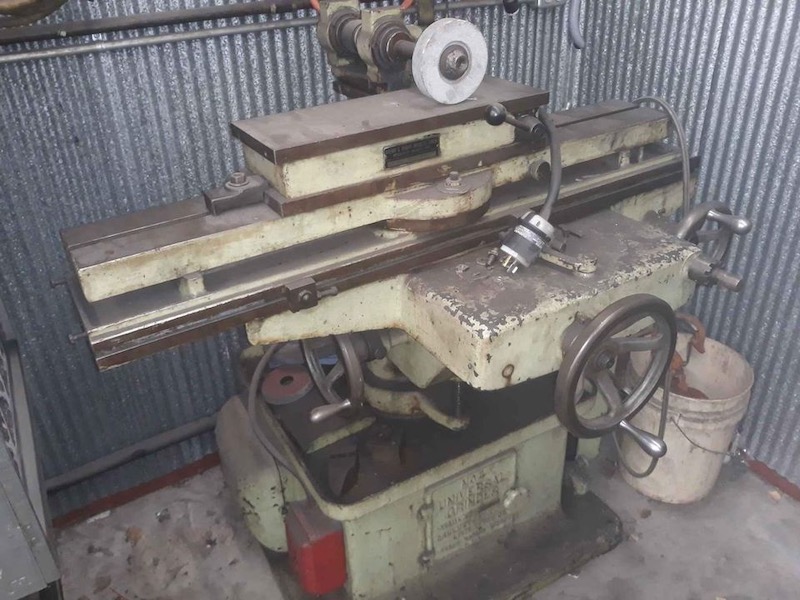
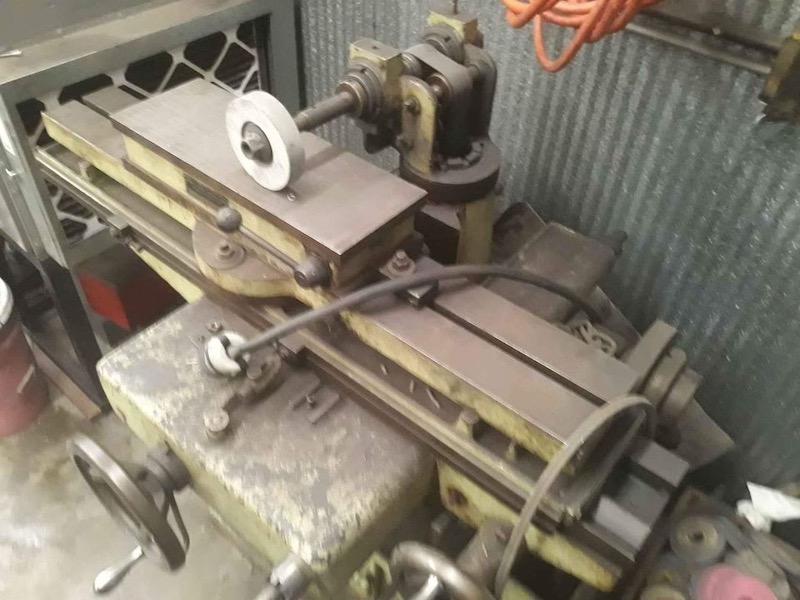
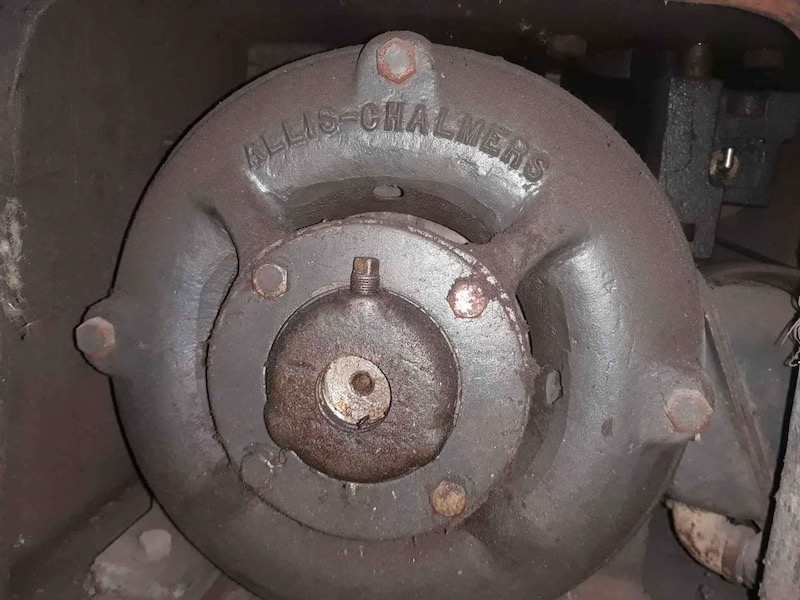
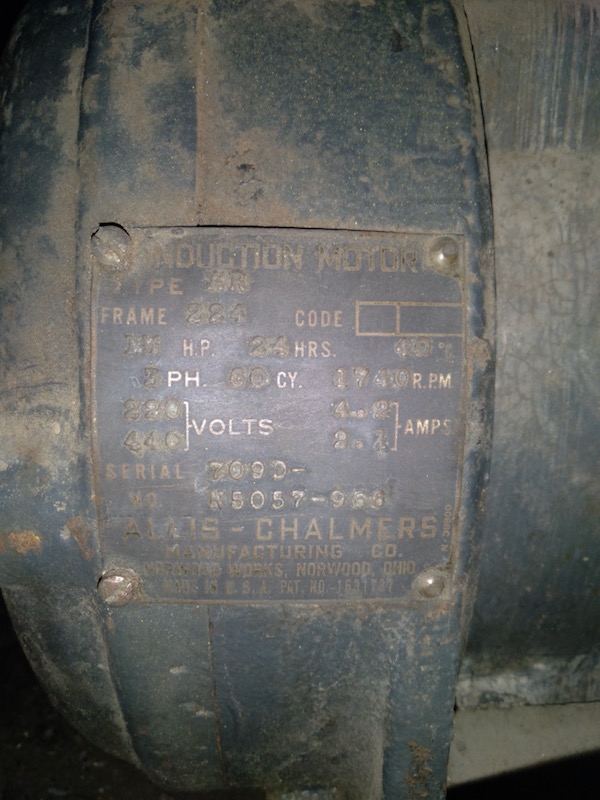


 IBWD MIke wrote:
IBWD MIke wrote:

